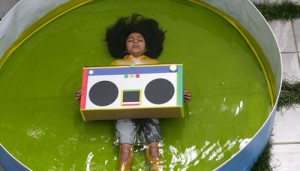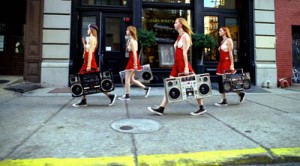« Features
To Hell with the Sublime / Luis Gispert and the Art of the Sublime
By Janet Batet
To hell with the sublime? That’s not acceptable. It’s just that desire pushes us towards rudeness. Why the compulsive need to swear? Why the propensity towards the profanity? And, what ties it to the field of art?
The answer appears to be associated with a quasi inherent concept within western art: the sublime. Associated for centuries with the immeasurable, the sublime, formulated as a category since Greek classicism, was rediscovered during the Rennaissance, reaching its peak with the Baroque and Romanticism. Then, the sublime was associated with the most passionate relationships. We no longer encounter the classical concept that pairs the sublime with the enjoyment of pure beauty that bedazzles us, but rather we confront conflictive, turbulent feelings that cause us more agitation than serenity. The sublime is now viewed there where the soul struggles and founders.

Luis Gispert. Piss Pool, 2006 (still from Smother). Courtesy of Zach Feuer Gallery and Mary Boone, NY
This tragic condition is paramount to understanding the sublime in the contemporary world. Associated with what Lyotard calls an aporia of reason, the sublime is only understandable from the multiplicity and instability that characterizes the postmodern world.
Fredric Jameson brings vital substantivization to sublime; a cornerstone, in my opinion, for the full understanding of Gispert’s oeuvre. I refer to Hysterical Sublime. For Jameson, the contemporary world is defined by an entirely new and de-centered global network. In the midst of this massive dystopian horizon, where historicity and nationalities are weakened to the extreme and even nature appears to be eclipsed, the revolt becomes a common expression and sign of identity.
Feeling, as a basic ingredient underlying creation, disappears. We could better yet -warns Jameson- speak of intensities: a free-floating and impersonal intensity that tends to be dominated by a certain euphoria, discourse marked by degradation and pastiche, where the obliteration of hierarchies between so-called high culture and mass culture is made manifest. It is precisely in this gap that Luis Gispert’s meticulous and controversial oeuvre can be found.
Luis Gispert was born in New Jersey in 1972 and later moved with his family to Miami where he spent his formative years. His experiences during childhood and adolescence in the turbulent nineteen-eighties would definitively mark his work, which always revolves around urban culture and within it, hip-hop, Latin ghetto, the youth culture and Cuban-American cultural heritage specifically.
The nineteen-eighties would signify for the urban culture the emergence and consolidation of hip-hop and for Miami, the sporadic and stunted growth associated with the Cocaine Wars. It is in the midst of this environment that Luis Gispert is solidified as an artist.
Gispert’s oeuvre is first of all distinguished by the high level of indiscriminate inclusivism that fuels it, generating a highly layered production as much from a visual as from a conceptual point of view. It could be said that three principal sources fuel his discourse: the car and sound systems culture, the hip-hop and disc jockey culture, and Cuban-American heritage. Looking at the expressive media utilized, three core groups can be identified: photographs, artifacts and film.

Luis Gispert. Blasterettes, 2004. Fuijiflex print. 27” x 39”. Edition of 6. In collaboration with Jeffrey Reed (Still image from Steromongrel). Courtesy of Zach Feuer Gallery, New York
Always impeccable, glossy and ostentatiously fake, Luis Gispert’s photography stands out as overt simulation. In his Cheerleaders series, the observer has the sensation of being behind the scenes. Gispert resorts to the green screen, depriving his characters of any context and flattening the depth of the image that is now reduced to a single plane. Its theatricality and fictitious nature is reaffirmed by the caricatural exaggeration that distinguishes its characters, loaded with the gestures and symbols that distinguish the cultural subgroup to which they belong.
From very early on in his career, Gispert was attracted to the world of sports and speed. In this context, of note is Goalie, 2000, where the artist introduced key elements that would mark his subsequent poetic such as a reference to mass culture and violence. The taste for speed is presented here by antithesis. Reduced to the movement of a single frame as required by photography, the hero appears suspended in the air: a kind of levitation that leads us to ecstasy and if not - at a minimum - to the full enjoyment that the ephemeral intensity of the moment brings. That is what Jameson coins as one of the distinctive signs of Hysterical Sublime in contemporary times: the free-floating and impersonal intensity.
If the world of cheerleaders is the perfect place to discuss marginal culture, urban youth culture, mass culture and ghetto culture versus the dominant or mainstream culture, as well as the dreams, stigmas and infiltrations that permeate one or the other; in 2003, Gispert undertook another photographic series in which he researched his Cuban-American heritage. The series is a manifestation of peripheral culture and desire - as far as immigrant culture is concerned. In it levitation plays an essential role, which here becomes the suspension of the future, of the temporal: the exile of Cronus.
This series is associated with reminescences, with the past. It is the magnification at a distance of the place of origin that becomes a chimera, frozen and idealized in the mind of the immigrant. In this sense, pastiche becomes essential. From stories he has heard, Gispert puts together identity icons from yesteryear frozen in time. The rarefied atmosphere stresses a stereoscopic sensation in which there is no substantivation or hierarchy; all elements are raised to the same level. Here we witness a trans-identity expression, where no objective decantation is possible, all density being lost. When all is said and done, we witness a massive dystopian horizon that fits perfectly into what Gispert labels dysfunctional aesthetics.
With Gispert, the multimedia sculpture or artifact finds as its central motif, the car and the boom box. Both items have inhabited the artist’s imagination since his adolescence when he modified and installed sound systems in his friends’ cars. The boom box then becomes a central element: an object of adoration as well as a symbol of belonging to a kind of brotherhood, a kind of totem around which daily life, dreams and utopias are structured. Clearly sexual in nature, the boom box is also that beat that encourages our existence and compels us.
Sometimes the boom box and the car become an entirely new entity, a kind of cyborg, capable of existing, suffering, loving and fading. These living entities are taken up again in his most recent photographic series, where the car turns into a propitious window, as well as the center of operations, through which we perceive our surroundings and control our universe. Enormous converted autos become the overcoat as well as the shelter of a nomadic race.
If one element could summarize Luis Gispert’s work, it is the pastiche that, finally free of prejudice, contaminates some of his series. In History will Absolve me, 2008, the artist plays with the juxtaposition of the elements of urban culture like graffiti and suburban developments, as well as the incorporation of the boom box - imbued here with completely new meanings - and the specific historic element used as the title of the work, which openly alludes to a crucial moment in Cuban history.
If a single passion has guided Gispert since his first artistic incursions, it has been cinema. Among the figures who have marked his style, of note are Buñuel, Fellini and Antonioni. This explains to a certain extent his taste for non-diegetic film elements, the prevalence of fantastic, barroque images, and rarefied atmospheres, disturbing universes, loaded with seemingly unconnected elements, necessitating the spectator’s rapid, willy-nilly ingestion and enabling subsequent reconstruction, usually possible only after the film is over.
In Steromongruel, 2005, he constructs a marvelous contemporary urban fable. Produced in collaboration with Jeffrey Reed, we witness a polished work of a self-referential nature in which the museum space is converted into a place where there is a convergence of Hortensia’s oppressive universe and the pile of influences and disparate recollections that torment and at the same time form the identity of this barely twelve-year-old adolescent.
In Smother, 2008, Gispert presents us with a more autobiographical film. The artist even underwent three years of psychoanalysis to reveal hidden moments from his childhood. The 28-minute film is sort of reminiscent of John Carpenter’s horror and science fiction films so popular in the nineteen-eighties and the special effects of the pre-digital era. With clear reference to the bloody Cocaine Wars in Miami - the environment in which Gispert grew up - the short film alludes to and pays homage to Scarface. Rarefied, degraded atmospheres, clearly Art Deco style, the presence of the boom box and violence; the film is a stimulating, frightening compendium, where alienation, absurdity and childhood imagination trace a tragic destiny.
The final metamorphosis presents the conversion of boy into dog and then into boom box, the latter rescued by the same rastafarians whom the little boy idolized at the beginning of the film. According to Gispert, this work marks a vital milestone in his career where the boom box has already served its purpose.
Let us wait and see what new frontier will be visited by this artist, within the new massive dystopian horizon that defines contemporary society. Meanwhile let us enjoy the sublime of the beat: the echo of revolt that has marked Gispert’s artistic production for more than a decade.
Notes
1- Fredric Jameson. Postmodernism, Or, The Cultural Logic of Late Capitalism. Edition: 3, Duke University Press, 1992, p. 34.
The first solo museum exhibition of Luis Gispert is on view at Museum of Contemporary Art of North Miami (MOCA at Goldman Warehouse) through June 27, 2009.
Janet Batet: Independent art critic and curator. BA in Art History (University of Havana); MA in Multimedia (UQAM University, Montreal)


































